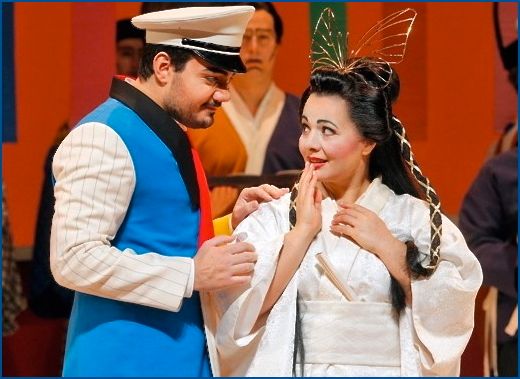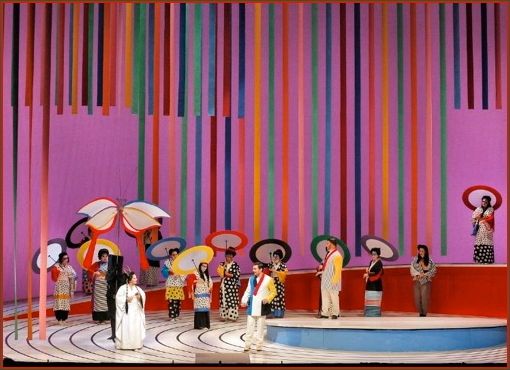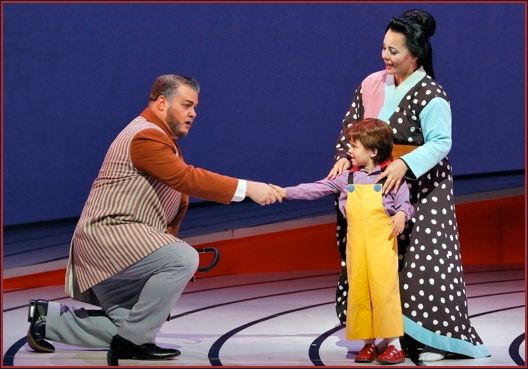Puccini’s Madame Butterfly and San Francisco Opera have been a lucky match since that one-night-stand conducted by Gaetano Merola over at Civic Auditorium back in September of ’24. The leading lady that night was Thalia Sabanieeva, a Greek soprano who had made her Met debut in the role the year before and at the last minute. Ninety-plus years later, an astonishing roster of internationally renowned sopranos have come to the City to perform “Cio-Cio-San” – including numerous repeat performances by Licia Albanese, Dorothy Kirsten, and San Francisco’s own Patricia Racette who starred in the 2014 premiere of Jun Kaneko’s colorful minimalist production. The revival, now at the War Memorial through Sunday, December 4, features Armenian soprano Lianna Haroutounian. Since the opening performance, it’s been one massive love-at-first-sight affair. Again! Lianna made her Company debut two years ago as “Tosca” with a cast that included Brian Jagde as “Cavaradossi” and Mark Delavan as “Scarpia”. The vocals were thrilling and the erotic side of the story as big as life.

Lianna Haroutounian as “Cio-Cio-San”
“Tosca was a very important debut for me,” said Lianna. “It brought me much success, beautiful reviews, the audiences were warm and passionate and gave me standing ovations. I was surprised and happy. I’ve been waiting to return to San Francisco. I’m so glad it’s as Butterfly. I’ve loved the opera since I first heard it. I fell in love with the music, the story, and how it can truly touch the heart. I like this minimalist set. It keeps everything focused on the expression, on the emotions. We’re not distracted by anything else.”
When she was still studying in Armenia, Lianna exhibited a naturally large range that extended from the Low-A of a mezzo-soprano to the High F of a coloratura soprano. That ability can be confusing to a young career-bound singer, particularly in operatic literature where specific vocal-types are assigned to roles written for them. Auditions for music schools, advanced training programs, vocal scholarships, etc., are highly competitive situations. It helps to be well-informed when doing what is supposed to come naturally.

Vincenzo Costanzo (as Pinkerton) and Lianna Haroutounian
“I could sing from Azucena to the Queen of the Night, without any ‘struttura’ [structure, technique] – whatever I liked. My voice just naturally allowed me to sing this range of notes. It was good – but, also not so good. I continued my studies in Paris at the Centre de Formation Lyrique de l’Opéra-Bastille. It’s like the young artists programs here. I was around twenty when I auditioned. I sang Leonora’s aria from Trovatore – ‘D'amor sull'ali rosee’. It’s very difficult, but beautiful vocally. I began working with coaches such as Janine Reiss and Robert Kettelson – studying French, Italian, and German. And learning about the soprano repertoire – the roles I should continue studying and those I should avoid. I learned by watching rehearsals in the Bastille Theatre. I observed famous singers in a very close working environment.
“My first Butterfly was at a small festival in France, the Festival de Sanxay. It was directed by Mario Pontiggia. My last performance of it was in concert at Concertgebouw, Amsterdam. There was some staging, I played the role through the entire presentation. It doesn’t work without acting. All the emotions become very concentrated, everything is focused on the singing. The audience becomes part of the experience because they are very close. I can make eye contact with them, see their expression. I love it! The audience enters into the story, they become part of my story. Butterfly is very text-based. It is also very theatrical, very natural and close to our lives. The opera is sentimental, with so much emotion in every note. It is important to live the story and bring everyone into it.”

ACT I – "Madama Butterfly"
Madama Butterfly is filled with little moments, subtle gestures, and abundant opportunities for coloring the voice. As a girl of fifteen – with a complicated personal and family history that includes loss of fortune, the shame of the father’s enforced suicide, her experience as a geisha / street singer, the abandonment of her religion in favor of her American husband’s Christian god (“Maybe He doesn’t know where we live...”) – Puccini demands an uber performer with a phenomenal capacity to convey everything from extreme modesty to ultimate betrayal, then at the finale – profound determination. Lianna Haroutounian is that consummate actress.
“I worked with the director in Paris. He helped me to understand the role, to find the most natural way possible. It is a real drama. We must forget about the vocal difficulties and just tell the story. The opera is beautiful all the time. Just do it! For example, when she hears the cannon from the harbor and sees the white ship with its name, Abraham Lincoln. She knows Pinkerton has returned and says, ‘Trionfa il mio amor! Il mio amor; la mia fè trionfa intera. Ei torna e m'ama!’ [”My love triumphs! My love, my faith has totally won. He has returned and he loves me.”] It is a very difficult moment, the words have to be full of emotion. She understands that her long wait hasn’t been for nothing and everybody around her was wrong. But as she gets it, little by little, that the strange woman is his wife – her reactions and thoughts must look very spontaneous. We have to see it with little looks, small hand gestures. Puccini was a genius – putting brief silences between the words and the actions, building up the tension. It is one of the most vital scenes. It is important to stay surprised. Her feelings, her physical reaction – it is all happening for the first time.
“When I arrived in San Francisco, I already had my conception of the role and a vision of how it would look. But I am very open to suggestions and feedback. I need to understand what they want from me – the point of view, their thoughts about the play, how they see Butterfly’s character development. During the final week of rehearsal I combined the exterior information with the interior information and formed my Butterfly. I am developing her character throughout every performance! I love this opera – there are so many aspects of the character. She is young, she is a mother, then she’s waiting, and at the end she is a samurai.”

Anthony Clark Evans, Ayla Cashman, and Lianna Haroutounian
Finally, I pressed Lianna to name her opera of choice for a future engagement with San Francisco Opera. Her answer sparked a vision of devoted fans wrapped around the block.
“Adrianna Lecouvreur. The first time I sang Adrianna was last February in concert at Théâtre Royal de La Monnaie. I’m in love with this role. It has everything – drama, monologue, love, passion, beautiful music and a beautiful vocal line. I would love to come back for this opera. San Francisco has brought a lot of success to my career. I know the audiences are waiting for me to come back. And I’ll be waiting to come back to them.”